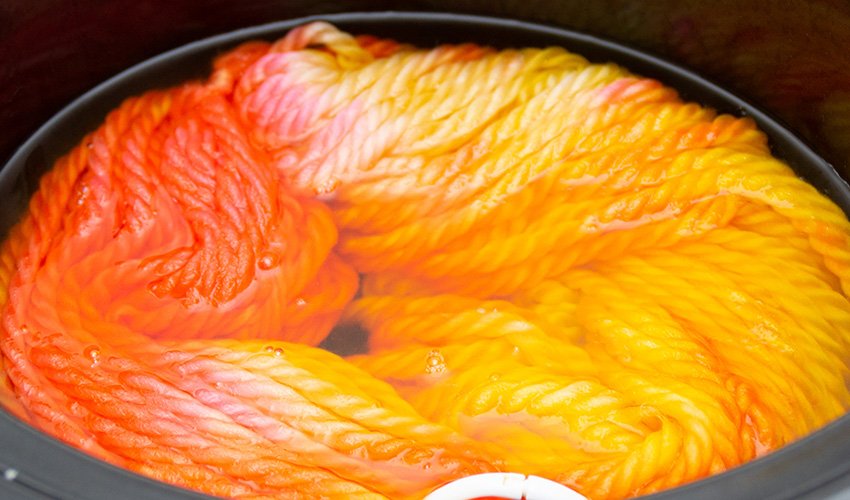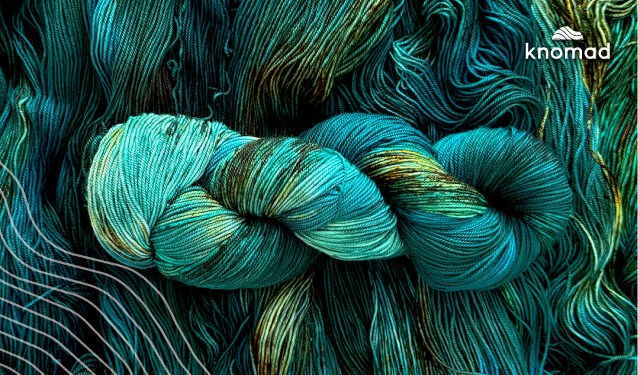Basic Dye Terms
Whether you are a veteran dyer or just getting started, there are a wide variety of terms that are helpful to learn. Today on the blog we are going to cover a variety of dyeing terms that will be useful to you wherever you are in your dyeing journey. Let’s get to it!
Acidic
A pH less than 7. Many dyes require an acidic environment, which can be created by adding white vinegar or citric acid into the dye bath.
Acid dye
An acid dye is a broad category of dye that is used primarily on protein fibres. The acid refers to the environment necessary for the dye molecules to bond to the fibre. Acid is added to the dye bath along with the dye. Dyes in this category include commercially made powder dyes that require acid or Kool-Aid and food coloring.
Adjective dye
Adjective dyes are any dyes that require the use of a mordant or fixative to properly bond the pigment to the yarn. Many natural dyes are adjective dyes and require mordants such as alum for the color to properly adhere to the fibre.
Base yarn
A base yarn is another way to say undyed yarn. Different fibre compositions react to different dyes. We recommend recording which base yarn you use in your dyer’s journal.
Basic
A pH greater than 7. The opposite of acidic. Some dyes can be shifted, meaning the color will change if the dye solution is made more acidic or basic.
Cake
When your finished yarn is wound into a cake using a ball winder and swift, it is often called a cake of yarn. This step is typically done after your yarn has been dyed and dried, right before you’re about to start your project.
Cellulose fibres
Cellulose fibres are plant-derived fibres like cotton, linen, and Tencel.
Colorfast
A dye that does not wash out or fade is considered colorfast. Colorfastness varies depending on the dye and mordants used.
Dye
Dye is anything used to add color to or change the color of something, in our case that something is yarn!
Dyebath
A dyebath is typically used in kettle dyeing, immersion dyeing, or low immersion dyeing. A dyebath is the liquid solution that contains the dye.
Exhaust
When a dye bath is exhausted, it means that all of the dye pigment has been absorbed. The dye bath will be clear.
Figure-eight ties
These are the ties used to keep a hank from tangling in the dyeing process. Read more about adding figure-eight ties in the post about preparing your yarn for dyeing.
Fixative
Can be used interchangeably with mordant. This refers to any substance that causes the dye to bond to the fibre. Common fixatives are vinegar, citric acid, and alum.
Garment dyed
A process in which the finished garment or product is dyed. Knitting or crocheting a hat in bare yarn and then dyeing it afterward.
Hand-painted
A process in which a hank of yarn is laid flat and dye is applied by hand either using squeeze bottles or a brush. This process allows for careful and precise application of color but is time-intensive.
Hank
A loop of yarn ready for dyeing. Knomad yarn comes twisted into a skein – untwist it and you have a hank.
Heat setting
Applying heat to dyed yarn to ensure that the dye molecules bond to the fibre. Heat setting can be done using steam, simmering water, or even in the microwave.
Immersion dye
Dyeing in a large pot where the yarn is fully submerged. This is an effective method for creating even color. A large stainless steel pot is commonly used for this dyeing method.
Kettle Dye
Kettle dye involves dyeing and heat setting your yarn all in the same vessel. My favorite tool for this process is a crockpot. Kettle dyeing can create beautiful semi-solid colors or be used to create a soft fade between multiple colors like we did with food coloring dyed yarn. The transition between colors is typically softer than hand painted yarn.
Merino
Merino wool comes from a specific breed of sheep. The wool coming from Merino sheep is known for being soft and fine. You can find merino wool in these skeins of our bare yarn.
Mohair
Fibre from the angora goat, known for being soft, long, and silky. Mohair is used in Magnolia and Sand Dune.
Mordant
Can be used interchangeably with fixative. This refers to any substance that causes the dye to bond to the fibre. Common fixatives are vinegar, citric acid, and alum.
Mulberry silk
Silk from the cocoons of silkworms who feed on mulberry leaves. Silk is a great fibre for projects that require a soft drape. Learn more about silk here.
Natural dye
Natural dyes are any dyes derived directly from sources like plants, minerals, or in some cases invertebrates like the cochineal insect.
pH
A scale used to measure whether a solution is acidic or basic. Less than 7 is acidic and more than 7 is basic.
Primary colors
Red, yellow, and blue are primary colors. They create all other colors through mixing. Many dye companies list certain colors as primaries and these are a good starting place to experiment with mixing your own dye colors.
Protein fibres
Any fibre that is derived from an animal. In yarn dyeing, this typically refers to fibres like wool, mohair, cashmere, and silk.
Secondary colors
Colors created by combining two of the primary colors. Yellow and red create orange. Yellow and blue create green. Red and blue create violet.
Skein
A twisted hank of yarn. Knomad yarn arrives twisted into skeins.
Superwash
Yarn that has gone through a process to prevent it from felting in the wash. This process also results in dye being absorbed more quickly.
Tencel
A cellulose fibre made from wood pulp. Asperitas is 50% Tencel.
Variegated
Generally used to refer to yarn that has more than one color. It can also refer to yarn that has variations in the same color with light and dark shades of the same hue. Variegation can be achieved through kettle dyeing.
Wool
Commonly used in reference to sheep, but wool is the fluffy coat of any fibre mammal including goats and alpacas. Wool is shorn, cleaned, and spun into yarn. Learn more about our yarn creation process here.
Tags: asperitas, Beginners, Hand dyers, indie dyers, magnolia, sand dune















I’ve never dye anything but mainly I use cotton or fingering yarn. Which dye should be used on them and which yarn should I get from you? I love in Miami, Florida
Hi Ileana, cotton is typically dyed with fiber-reactive dyes. Wool, and protein-based yarns, like ours, are generally dyed with acid dyes. We love using Dharma Trading Acid Dyes, but you can use many other brands with great results. A great fingering weight, superwash merino yarn of ours to begin dyeing with is SNOWDRIFT! Best of luck!